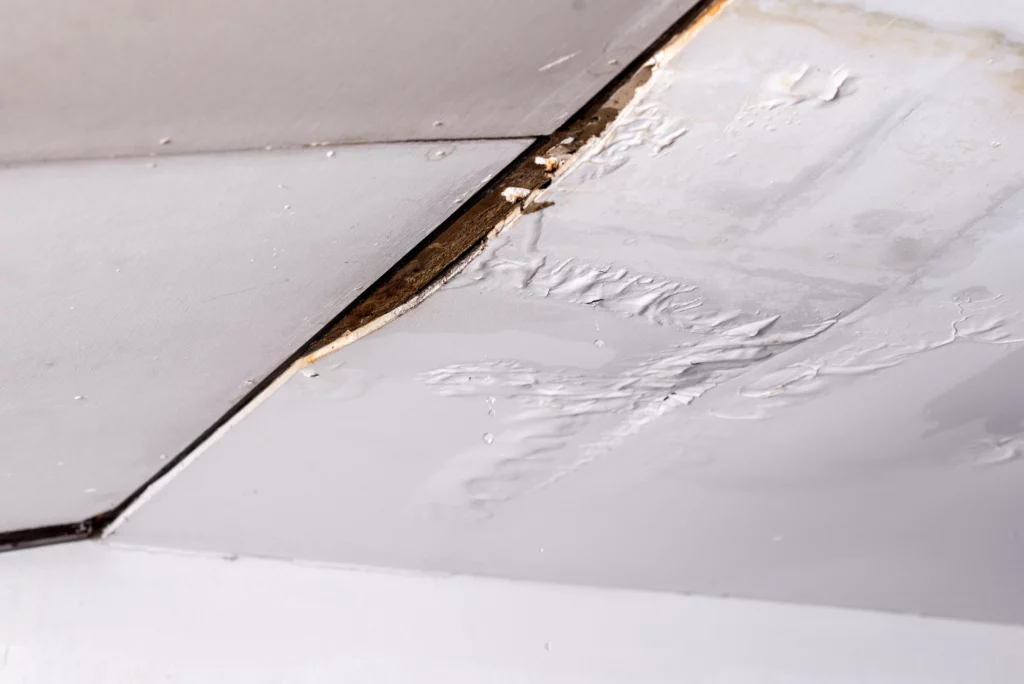A leaking roof can cause a multitude of issues for homeowners, ranging from minor annoyances to major structural damage. In this article, we will explore 10 common issues that can arise from a leaking roof. These issues include water damage to ceilings and walls, mold growth, decreased energy efficiency, compromised structural integrity, decreased property value, increased risk of electrical hazards, and potential health risks. By understanding these issues, homeowners can take proactive measures to prevent or address leaking roofs before they become a more significant problem.
1. Attic, Ceiling, and Paint Damage
One of the most obvious and visible effects of a leaking roof is damage to the attic, ceiling, and paint. Water seeping through the roof can cause stains, discoloration, and peeling paint on the ceiling and walls. Over time, the water can weaken the ceiling’s structure, causing it to sag or even collapse.
2. Mold Growth
A leaking roof can create a moist environment that is ideal for mold growth. Mold can quickly spread and cause respiratory problems, allergies, and other health issues. If you notice a musty smell or see black spots on your ceilings or walls, you may have mold growth.
3. Decreased Energy Efficiency
A leaking roof can reduce the insulation’s effectiveness, leading to increased energy bills. The insulation can become wet and compressed, making it less effective in regulating the temperature inside the house.
4. Compromised Structural Integrity
Water can damage the roof’s structural components, including the trusses, rafters, and decking. Over time, this can compromise the roof’s strength and stability, making it more susceptible to collapse during heavy rain or snow.
5. Decreased Property Value
A leaking roof can significantly decrease a property’s value. Potential buyers may see a leaking roof as a sign of neglect and expect to pay less for the property.
6. Increased Risk of Electrical Hazards
A leaking roof can create an electrical hazard if water seeps into the electrical system. Water can cause short circuits, which can cause fires or shock hazards.
7. Potential Health Risks
Mold growth caused by a leaking roof can create health risks for homeowners. Mold spores can cause respiratory problems, allergies, and other health issues, particularly in children, the elderly, and people with weakened immune systems.
8. Pest Infestations
A leaking roof can create an ideal environment for pests such as rodents, termites, and other insects. These pests can cause damage to the roof’s structure and create health risks for homeowners.
9. Decreased Comfort
A leaking roof can make the home less comfortable. Water can seep into the insulation, making it less effective in regulating the temperature inside the house. This can lead to drafts and temperature fluctuations that make the home less comfortable.
10. Higher Maintenance Costs
A leaking roof can lead to higher maintenance costs, as homeowners may need to replace damaged insulation, repair water damage to ceilings and walls, and address other issues caused by the leak.
Conclusion
In a nutshell, a leaking roof can cause a multitude of problems for homeowners, ranging from minor annoyances to major structural damage. By understanding these issues, homeowners can take proactive measures to prevent or address leaking roofs before they become a more significant problem. Regular roof inspections, timely repairs, and proper maintenance can help prevent many of these issues and ensure a safe and comfortable home.
If you need help from a contractor for roofing, contact J. Carnes & Son Roofing. We are considered the leading and most trusted residential roofing contractor in New Hampshire and Southern Maine. Contact us and let us know what you need for your roof today!

